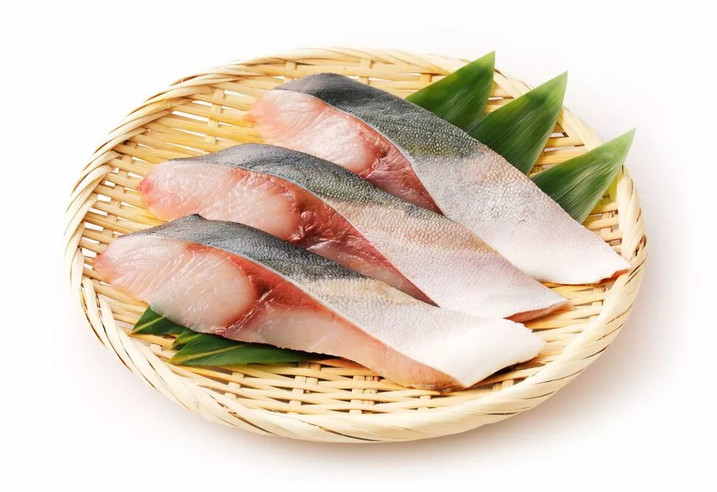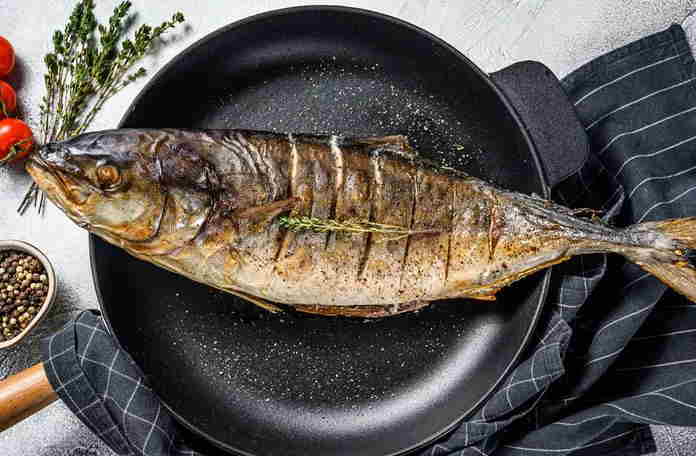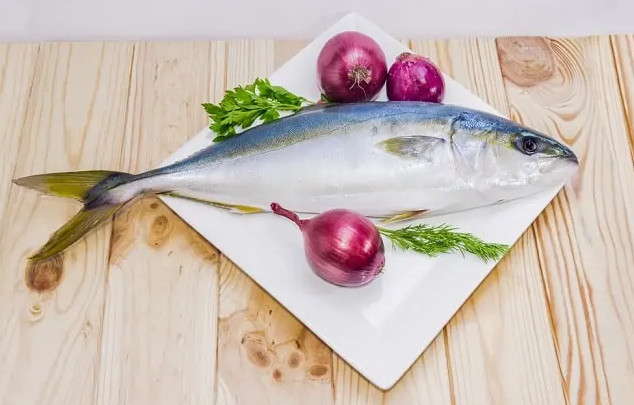Yellowtail is a type of fish that is widely popular around the world. It is known for its mild flavor and buttery texture, making it a favorite among seafood lovers.
In this article, we will explore What Does Yellowtail Taste Like?, appearance, nutritional value, and cooking methods of yellowtail.
Contents
- 1 Definition of Yellowtail
- 2 Where Yellowtail is Commonly Found
- 3 Reasons for the Popularity of Yellowtail
- 4 Appearance of Yellowtail
- 5 What Does Yellowtail Taste Like?
- 6 Comparing Yellowtail to Other Fish
- 7 Nutritional Value of Yellowtail
- 8 Cooking and Serving Yellowtail
- 9 Does Yellowtail Taste Better Than Tuna?
- 10 Conclusion
- 11 FAQs
Definition of Yellowtail
Yellowtail is a type of fish that belongs to the Jack family. It is also known as Hamachi or Buri in Japanese.
Yellowtail is a saltwater fish that is commonly found in the Pacific Ocean, especially in the waters surrounding Japan, Australia, and New Zealand.
Where Yellowtail is Commonly Found
Yellowtail is a popular fish in Japanese cuisine and is commonly found in sushi restaurants. It is also a popular ingredient in many other cuisines, including Korean, Chinese, and Western cuisine.
Yellowtail is often sold fresh or frozen in Asian markets or specialty seafood stores.
Reasons for the Popularity of Yellowtail
The popularity of yellowtail can be attributed to its mild and buttery flavor, which is often compared to that of salmon, Mackerel or tuna.
It is also a versatile fish that can be prepared in a variety of ways, including grilled, sautéed, or served raw as sashimi or sushi.

Appearance of Yellowtail
Yellowtail is a large fish that can grow up to 6 feet in length and weigh up to 200 pounds. It has a long, slender body with a distinctive yellow stripe that runs along its sides.
The flesh of yellowtail is pinkish-white and has a firm texture.
Size
Yellowtail can vary in size, but on average, it measures between 18-36 inches in length and weighs around 10-20 pounds.
Shape
Yellowtail has a long, cylindrical body with a pointed head and a forked tail. It has a streamlined shape, which allows it to swim quickly through the water.
Color
The skin of yellowtail is usually dark blue or greenish-blue on the top and fades to a lighter shade of blue or silver on the bottom. Its flesh is pinkish-white and may have a slightly yellow tint.
Skin and Scales
Yellowtail has tough, thick skin that is covered in small scales. The skin is usually removed before cooking, but the scales are often left on to help protect the flesh.
What Does Yellowtail Taste Like?

Yellowtail has a distinct flavor that is often described as mild, buttery, and slightly sweet. It has a delicate texture that is firm, yet tender, and melts in your mouth. Yellowtail is not as oily as salmon or tuna, which gives it a lighter taste that is less overpowering.
Flavor
The flavor of yellowtail can vary depending on its preparation and cooking method. When served raw as sashimi or sushi, yellowtail has a subtle taste that is enhanced by dipping it in soy sauce and wasabi. Grilled or pan-fried yellowtail has a slightly smoky taste that pairs well with citrus or herb-based sauces.
Texture
Yellowtail has a firm texture that is similar to that of tuna or swordfish. It is not as flaky as other white fish, which makes it a popular ingredient in sushi and sashimi dishes. When cooked, yellowtail has a tender texture that is moist and juicy.
Aroma
Yellowtail has a mild aroma that is similar to other white fish, such as cod or halibut. It does not have a strong, fishy smell, which makes it appealing to those who are not fans of seafood.
Comparing Yellowtail to Other Fish
Yellowtail is often compared to other types of fish, such as salmon, tuna, and sea bass. While it has a similar taste and texture to these fish, yellowtail has a milder flavor and is less oily.
This makes it a good choice for those who are looking for a lighter, less overpowering seafood option.
Nutritional Value of Yellowtail
Yellowtail is a nutritious fish that is rich in protein, vitamins, and minerals. It is a good source of omega-3 fatty acids, which are essential for maintaining a healthy heart and brain.
Protein
Yellowtail is a high-protein food that contains around 23 grams of protein per 3-ounce serving. Protein is essential for building and repairing muscle tissue and is important for overall health and wellbeing.
Fat Content
Yellowtail is a low-fat fish that contains around 3 grams of fat per 3-ounce serving. It is a good source of healthy fats, such as omega-3 fatty acids, which help to reduce inflammation and lower the risk of heart disease.
Vitamins and Minerals
Yellowtail is a good source of vitamins and minerals, including vitamin B12, vitamin D, selenium, and potassium. These nutrients are important for maintaining healthy bones, muscles, and immune function.
Health Benefits
Eating yellowtail can provide several health benefits, including reducing the risk of heart disease, improving brain function, and reducing inflammation in the body. The omega-3 fatty acids found in yellowtail can also help to lower cholesterol levels and improve joint health.
Cooking and Serving Yellowtail
Yellowtail is a versatile fish that can be prepared in a variety of ways, including grilling, sautéing, baking, or serving raw as sushi or sashimi.
Preparation
Before cooking yellowtail, it is important to remove the skin and any bones. Yellowtail is typically sold as fillets, which can be cut into smaller pieces for grilling or sautéing. When serving yellowtail raw as sushi or sashimi, it is important to use a sharp knife to ensure clean, even cuts.
Cooking Techniques
Yellowtail can be cooked using a variety of techniques, including grilling, sautéing, baking, or poaching. It is important not to overcook yellowtail, as it can become dry and lose its delicate flavor and texture.
Serving Suggestions
Yellowtail can be served on its own as a main dish, or paired with a variety of side dishes. Some popular serving suggestions include serving yellowtail with a side of steamed rice, roasted vegetables, or a fresh salad. It also pairs well with citrus-based sauces or marinades, which complement its mild flavor and delicate texture.
Does Yellowtail Taste Better Than Tuna?
The question of whether yellowtail tastes better than tuna is ultimately subjective and depends on personal preference. Both fish are popular seafood choices and offer distinct flavors and textures that appeal to different palates.
Yellowtail has a mild, sweet flavor with a slightly chewy texture. It’s also less fatty than tuna, which can make it a healthier option. Many people enjoy yellowtail for its delicate flavor, which makes it a popular choice for sushi and sashimi.
Tuna, on the other hand, has a more assertive flavor and tends to be meatier and oilier than yellowtail. Some people prefer this stronger flavor and the richness of the fish. Tuna is also a versatile fish that can be prepared in many different ways, making it a go-to option for many seafood dishes.
Ultimately, whether yellowtail or tuna tastes better is a matter of personal taste. Some people may prefer the subtler, sweeter flavor of yellowtail, while others may prefer the stronger, richer flavor of tuna. Both fish are delicious and offer their own unique qualities, so it’s worth trying both to determine which one you prefer.
Conclusion
So, now you know “What Does Yellowtail Taste Like?”, Yellowtail is a delicious and nutritious fish that is popular in many different types of cuisine. It has a mild, buttery flavor and a firm yet tender texture, making it a versatile ingredient that can be prepared in a variety of ways. Whether you are grilling, sautéing, or serving it raw as sushi, yellowtail is sure to please even the most discerning seafood lover.
FAQs
- What is yellowtail?
Yellowtail is a type of fish that is found in warm and temperate waters around the world. It is known for its mild, buttery flavor and firm yet tender texture.
- What Does Yellowtail Taste Like?
Yellowtail has a mild, buttery flavor that is slightly sweet. It is not as oily as other types of fish, which gives it a lighter taste that is less overpowering.
- Is yellowtail healthy?
Yes, yellowtail is a nutritious fish that is rich in protein, vitamins, and minerals. It is a good source of omega-3 fatty acids, which are essential for maintaining a healthy heart and brain.
- How is yellowtail prepared?
Yellowtail can be prepared in a variety of ways, including grilling, sautéing, baking, or serving raw as sushi or sashimi. It pairs well with citrus-based sauces or marinades, which complement its mild flavor and delicate texture.
- Where can I buy yellowtail?
Yellowtail can be found at most seafood markets and specialty grocery stores. It is also available online through various retailers.
